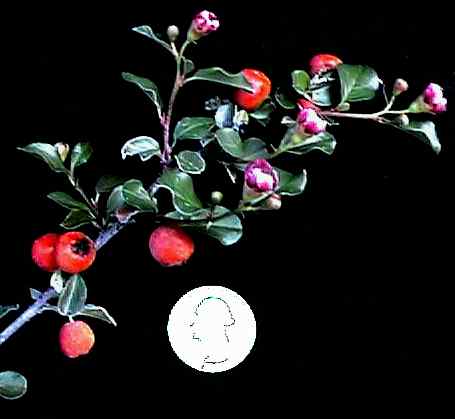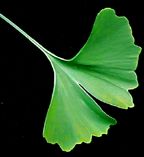2 3/4 INCH POTS $18
FOUR INCH POTS $27
ONE GALLON SIZE $55

| Articles | Home Page | Images | Order Form | Plant Catalog |
Cotoneaster (Benishitan) Deciduous and semi-evergreen shrubs with white or pink flowers with reddish berries. Some forms are variegated. Easy to grow plants for the landscape, rock garden, or bonsai. Cotoneaster continues to be one of the most popular plants for bonsai, especially for beginners since it may be styled and potted at a very young age and the flowers and fruit on these young plants can be quite striking. We grow many different varieties almost all of which are low growing and have good bonsai and rock garden potential.
For more information see the article Cotoneaster for Bonsai.
3230 Cotoneaster dammeri 'Streib's Findling'
S\M\-30ø\RG\Ls\B Slow growing evergreen mounding shrub to about 1 foot x 3
feet . Grows by short arching branches making it particularly useful for
bonsai. Dark green leaves almost round and red berries. One of the best
for small weeping bonsai!
2 3/4 INCH POTS $18
FOUR INCH POTS $27
ONE GALLON SIZE $55
Crataegus (Hawthorn) S\D\-40ø\Ls\B Deciduous trees with either white or pink flowers and small red apple-like fruits. Plants sucker and water sprout profusely. This can be controlled somewhat in landscape plants by limiting water and fertilizer and pruning only when necessary. Bonsai plants should have suckers removed as they appear. Leaves reduce nicely in bonsai plants. Seedling grown plants avoid nasty grafts for bonsai use but can take as long as 20 years to flower. Cutting grown plants are from mature wood, are capable of flowering immediately, and also avoid the graft problem. We are one of the very few nurseries in the world growing hawthorn from cuttings.
Specimen bonsai from cutting grown hawthorn are spectacular. The oak lobed leaves are very attractive and reduce nicely. A fine degree of ramification is possible once the roots are constrained in a bonsai pot. Older, well trained plants will be literally covered with flowers in the spring and loaded with ideal sized bright red fruit in the fall. The mature bark is scaly and in perfect proportion. Good branching is the most difficult aspect to achieve. New branches tend to shoot straight up, so young branches must be wired into position quickly. Once the branch framework is established, ramification is easily achieved through pinching the new growth.
Fagus (Beech) I will never forget the beeches of my childhood on the east coast. Enormous steel-gray smooth trunks almost fairy-like. Beech, European and Japanese, are very popular for bonsai, both as group plantings and individual specimen upright trees. We are very fortunate to be able to offer Japanese Beech a very rare tree in this country and extremely difficult to obtain.
All species of beech share the common trait of being quite different in leaf and bud from most other deciduous trees. Mature plants generally set one set of leaves per season. The leaf buds are thick and fleshy and not very numerous. This requires a different strategy for bonsai growing. In general, they should not be trunk chopped like other deciduous trees, but rather grown out using sacrifice branches to obtain caliper. It is difficult to get good taper to the apex and maintain the fine ramification that is necessary. A good apex requires planning ahead, selecting a small upright branch in a good location, and cutting back to this point.
Pruning scars are also a problem. The species tends to develop a thick callus which will create an unsightly bulge. This is especially difficult in the top of the tree when selecting the apex. I have found that wrapping the cut area tightly with grafting tape will help minimize the bulge, but you should still try to have the scars placed to the back of the tree.
Beech will back bud, but with difficulty. Plants that are to be cut back should be young and vigorously growing. Try not to remove all of the preformed buds or you may lose the tree. Buds tend to form at branch collars, so overly thick branches can be removed and new, thinner ones started in the same location if you leave a small stub. This method can also be used to grow new branches where older branches have all their foliage at the tips. Beech are generally not defoliated, although it is possible to do it every few years for show purposes.
4050 Fagus sylvatica Seedling trees of the
species for landscape or bonsai use. For bonsai may be used as specimen or
group planting. Our 2 3/4 inch pot size are relatively straight and are
about 12 to 16 inches tall with 1/4 inch or greater caliper. These are
transplanted root pruned field grown trees that are nicely branched.
Please note if you desire a range of sizes for a group planting.
2 3/4 INCH POTS $20 Available May 2025
FOUR INCH POTS $30
ONE GALLON SIZE $65
| Ginkgo biloba (Maidenhair Tree, Icho) S\M\-40ø\Ls\B Deciduous tree to 70 feet. Graceful upright tree with light green fan shaped leaves turning to solid yellow gold in fall. An ancient tree little changed from its fossilized ancestors. Native of China. Trees are male and female; females, producing smelly (like dog do do) fruits, are avoided as landscape trees. Trees for bonsai may be either sex. A traditional bonsai subject. Ginkgo need to be grown out to achieve a fairly large trunk caliper to be successful bonsai. They bud back very well, so there is no need to begin branch development early. They can easily be 'trunk chopped' to gain taper and trunk movement. They are adapted to formal and informal upright styling and often the branches are trained upward in a 'flame' arrangement, although this is not strictly necessary. Smaller Ginkgo can be used for group plantings. |  |
4350 Ginkgo biloba Unsexed seedling trees are
the most affordable bonsai material. Ginkgo will not form branches for
several years. Our 2 3/4 inch pots are one year and older whips and 4 to 6
inches tall.
ONE GALLON SIZE $55
5215 Ilex serrata (Japanese
Winterberry) S\PS\M\-20ø zone 5\B. Deciduous shrub 4 to 10 feet with white
flowers and red berries in winter on leafless stems. The flowers are quite
small and the brilliant red berries are about 3/16 inch. In a good year,
the shrub is covered with berries. Highly valued as bonsai for its winter
display. This species is dioecious (male and female flowers on separate
plants) but will set (probably sterile) fruit without the presence of the
male. Having a male plant nearby may increase fruit production. Please
specify female or male plants.
Available Again in 2026
| Articles | Home Page | Images | Order Form | Plant Catalog |